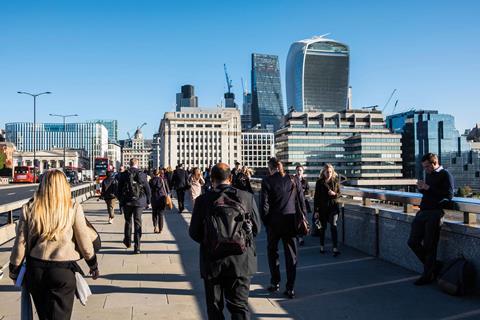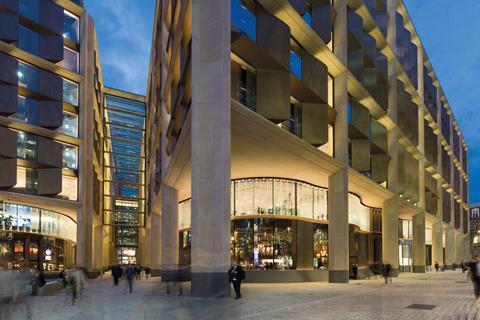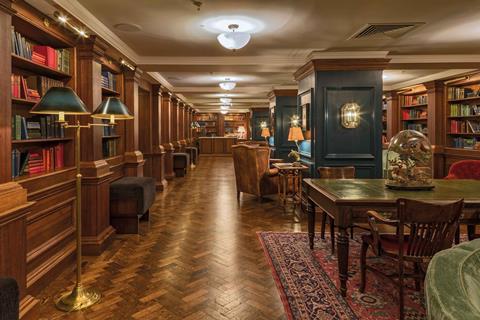The face of the City of London, once a bastion of the big banks, is getting fresher as smaller companies with younger workers move in. With co-working spaces and start-up incubators a growing trend, developers are finding that flexibility and fun public spaces are what occupiers want

An extra 1,200 start-ups a year started calling the City of London home in the six years to 2016, with the total number of businesses housed in the Square Mile soaring by 41%.
This statistic, from the City of London Corporation, encapsulates how the City is changing. The once financial-services-dominated Square Mile has seen a shift in the size and style of business taking up space in major commercial developments, forcing developers, planners and designers to create increasingly flexible workspaces.
With the number of tech firms and start-ups in the Square Mile on the rise, the average age of its workers is falling, with 61% of City workers aged between 22 and 39 ŌĆō compared with 40% across England and Wales ŌĆō which is also driving changes in what the City has traditionally offered.
This demographic change has influenced the design of both office and public space within the CityŌĆÖs limits, with the demands and desires of these younger workers driving a push for more bars, restaurants and retail outlets.
As the face of the City changes, those responsible for determining its future find it increasingly necessary to consider who will be using the space, how they will be using it ŌĆō and how what happens in the Square Mile can be an indicator for change in other locations.
ŌĆ£Ninety-nine percent of city occupiers are now smes of less than 250 peopleŌĆØ
Chris Hayward, City of London Corporation

New occupiers in the city
While the City was once purely the domain of large financial and professional service businesses, developers have seen a significant change in those taking space in new buildings. According to Chris Hayward, chairman of planning at the City of London, the occupier base has changed dramatically.
ŌĆ£Ninety-nine per cent of City occupiers are now SMEs of less than 250 people,ŌĆØ he says. ŌĆ£What else is interesting is the increasing diversity, not just financial and professional services companies but, for example, media and certainly fintech [financial technology] businesses coming into the City.ŌĆØ
Figures from PwC show the Square MileŌĆÖs computer consulting sector more than doubled between 2010 and 2016, while ONS statistics show information and communications firms accounted for 38,000 jobs in the City in 2016, up almost 60% from 2010.
Hayward says last yearŌĆÖs decisions by media giant Bloomberg and Innovate Finance, the independent not-for-profit association representing fintech firms, to set up shop in the Square Mile showed the areaŌĆÖs diversification.
The rise of groups setting out to run co-working offices is also a driving force within the CityŌĆÖs development market, according to Hayward. WeWork, for instance, a provider of shared workspaces and services, holds 232,000m2 of office space spread across 19 locations in and around the City, and doubled its Square Mile footprint in 2017.
ŌĆ£What is interesting is that people like WeWork are telling us they will acquire any buildings that they can get in the City. WeWork is such a radically different business model - itŌĆÖs a community, and itŌĆÖs about feeding that SME start-up market,ŌĆØ says Hayward.
WeWork lets individuals and businesses office space on a month-by-month basis, which can be cancelled at any time. This model represents a significant shift from the way office space was traditionally let in the City, where large corporations were tied to long-term leases.
A recent report from the City of London and the City Property Association, The City as a Place for People, also highlighted a cluster of creative businesses in Chancery Lane, including advertising and creative agency Saatchi & Saatchi, as an example of the changes occurring.
While his focus is no longer solely London-centric, Shard builder Flan McNamara ŌĆō who left Sellar Property Group after eight years to become a director at developer Vanguard Real Estate ŌĆō is keeping a close eye on trends within the City.
He agrees that groups looking to run co-working spaces in and around the City have been a significant factor in the areaŌĆÖs changing occupier base: ŌĆ£Certainly in London, if you take areas around Old Street for example, thatŌĆÖs exactly how the area has changed. There are lots of small start-up businesses, almost incubator type set-ups.
ŌĆ£One of the trends that really seems to be catching on with the big banks ŌĆō and I think RBS have been particularly good at it ŌĆō is that they are creating incubator spaces for start-up businesses. They create these spaces so that they can help them grow and they can give them some office space with cheap rent.ŌĆØ
He cites as a prime example RBSŌĆÖ collaboration in Islington, just north of the City, with RocketSpace ŌĆō a California-based company that provides co-working space for tech start-ups.
RBS had an existing relationship with RocketSpace, whose alumni include Uber and Spotify, having supported the companyŌĆÖs West Coast base in the US before helping to enable the London branch in 2016.
McNamara says that over the past five years start-ups have been pushed ever further into the heart of the City as they have expanded. ŌĆ£They have to move in because they are growing, and probably their only option in terms of growing is to take bigger office floorplates,ŌĆØ he says.

Office design and layout
Flexible, collaborative office floorplates are integral to cater for the increased diversity of tenant, according to the experts.
Richard Hutchinson, director at LOM ŌĆō the architecture firm that designed RocketSpaceŌĆÖs office in Regents House, just north of the City ŌĆō says the main concern for both start-up and established businesses is flexible spaces. ŌĆ£I canŌĆÖt think of any work we are doing that doesnŌĆÖt have a really healthy provision of collaborative breakout spaces to support both taking a time-out and different working patterns.
ŌĆ£ItŌĆÖs the range of different settings and the inherent adaptability of those settings. You have standard desking, but there are also an awful lot of breakout spaces, which range from very small, private, single-person spaces, to two-people focused spaces, through to larger team spaces and meeting rooms.ŌĆØ
Vanguard Real EstatesŌĆÖ McNamara says it is integral for these spaces to be designed as adaptable from the outset. ŌĆ£Some of these bigger buildings, where you might once have had someone take a big chunk of space: theyŌĆÖll now take a floor at a time or subdivide the floor. ItŌĆÖs certainly something thatŌĆÖs proved to be the case at London Bridge, with the spaces in the Shard. Quite a number of floors have been subdivided.
ŌĆ£ThatŌĆÖs providing technical challenges, because if the building isnŌĆÖt designed in a flexible way in the first place it is very difficult to do.ŌĆØ
Designing floorplates so they can be shared or divided involves a number of factors, according to McNamara: ŌĆ£To avoid having very long corridors you might design the building so it is able to be subdivided into four so, for example, the MEP services can be separately metered. ItŌĆÖs a simple thing but needs to be done from the outset.
ŌĆ£Toilets might be more evenly distributed across the floor rather than have one toilet block and you might have [ŌĆ”] two separate lobbies.ŌĆØ
He says it is paramount for spaces to be equally attractive to both large and small tenants. ŌĆ£The idea for us is to be able to offer the best of both worlds. It also allows for growth. TodayŌĆÖs start-up is tomorrowŌĆÖs Google.ŌĆØ
Matt Flood, commercial director at Landsec, agrees that increased diversity within the occupier base is driving flexible design. ŌĆ£There are some nuances in the requirements of these customers, but they are all united in their drive for greater dynamism and flexibility in the workplace,ŌĆØ he says.
ŌĆ£As a developer in the City, we need to proactively respond by creating places that enhance the userŌĆÖs experience, and to establish ourselves as a genuine partner for these businesses by offering a range of products and leasing models.ŌĆØ

Cultural change
With the type of firm occupying traditional corporate office space shifting, the workforce and in turn the culture of the City are also changing.
Hayward at the City of London says: ŌĆ£The workforce is getting younger; the guys walking around in suits and ties are becoming fewer. Developers are seeing that what the changing generation, the millennials, want in terms of workspace is very different than what their predecessors wanted. The market itself has to flex and adapt to cater for that. When I first came to the City 30 years ago, by six oŌĆÖclock in the evening everyone had left. TheyŌĆÖd either gone home or gone to the West End for their social life. Now, because we are also offering high-quality bars, restaurants and retail, more and more people are spending 24/7 [in the City].ŌĆØ
Hayward cites the Ned ŌĆō a hotel and membersŌĆÖ club with nine restaurants, indoor and rooftop pools, a gym, a spa and a Turkish bath ŌĆō and the well at the front of 1 Undershaft, which will house amenities including an ice rink, as examples of the changing cultural offerings within the Square Mile.
ŌĆ£You canŌĆÖt just pack office buildings in so tight that all you have is buildings. You must have quality public realm around them,ŌĆØ he says. ŌĆ£ItŌĆÖs everything from roof terraces to pocket parks to the general greening of buildings whenever we can, to spaces that arenŌĆÖt necessarily green spaces.
ŌĆ£We need hotels to service the office space. We need high-quality restaurants, bars and retail ŌĆō and to me all of that stuff is captured in public realm.ŌĆØ
Vanguard Real EstatesŌĆÖ McNamara says this cultural shift is also occurring within commercial buildings themselves. ŌĆ£My personal view is that people are coming out as graduates and they want to really enjoy their work time. They want an exciting place to work.
ŌĆ£Many of the smaller retail offerings are within these buildings. The buildings themselves are trying to create a cafe-like environment, as well as areas where you can hold parties and conferences.ŌĆØ
Hutchinson says adding these sorts of spaces is among the most common requests when his firm is updating existing City office space. ŌĆ£It needs to be designed in a way that when itŌĆÖs not being used for dining it can be used as a workspace,ŌĆØ he says.
ŌĆ£Those spaces are usually large gathering spaces, so if you have the right design, the right kind of furniture, the right kind of storage, they can be reconfigured for an evening seminar or a town hall event so that you can get the best use from that space.ŌĆØ
Beyond the city
The changing demographic of the people and businesses taking up residence in big commercial buildings is not limited to the Square Mile. Hayward at the City of London says the continued diversification of the once finance-focused Square Mile has also brought a ŌĆ£blurring of its boundariesŌĆØ. He says: ŌĆ£We are actually getting interconnected. Business doesnŌĆÖt understand physical boundaries ŌĆō it doesnŌĆÖt say the City ends here and Tower Hamlet starts there ŌĆō so thereŌĆÖs increasingly a sort of blurring happening.ŌĆØ
The Alphabeta building is cited by The City as a Place for People report as an example of this blurring. It has entrances facing both Shoreditch and the Square Mile and is home to a mix of financial and tech firms. Principal Place, AmazonŌĆÖs UK headquarters since last year, and also sited at the intersection of the City and Shoreditch, is another example.
In Canary Wharf, Level39, a flexible office space for tech start-ups, launched in March 2013. It has grown into a 80,000ft2 space occupying three floors of One Canada Square. The Canada Wharf Group says since since its launch it has hosted more than 100,000 visitors and 1,200 events.
McNamara at Vanguard Real estate, which works extensively in the UKŌĆÖs regional cities, says demand for increased flexibility in commercial buildings is also apparent in places such as Belfast and Glasgow. ŌĆ£Belfast is diversifying and itŌĆÖs short of grade-A office space,ŌĆØ he says.
ŌĆ£ThereŌĆÖs demand for the shared floorplates, but certainly they want the flexibility. We are doing five projects in Belfast and it is to meet a need of large corporates who want bigger floorplates where they can bring their business together. It also allows space for smaller companies to grow within the same building, if they can take a small space to start off with and then expand.ŌĆØ
That there is still room for new developments in regional cities allows more flexible buildings to be created from the outset, he says: ŌĆ£We are designing buildings in Belfast and Glasgow where we are building in that flexibility from day one.
ŌĆ£We are also trying to make the spaces much more edgy, so we are trying to a certain extent to almost pre-empt what tenants are looking for [ŌĆ”] The space needs to reflect the occupier as well.ŌĆØ


























No comments yet